Walk for Paws 2017 - BVSPCA
Thanks to 16 P2P teams, this campaign raised an astonishing $70,895 from over 251 donors. The campaign was paired with a road race to raise money for the Brandywine Valley SPCA.
Nonprofits of all shapes and sizes can use peer-to-peer fundraising as a supplemental fundraising tactic during their annual campaigns. Organizations that are looking to host a walkathon, marathon, or other fundraising event often look to peer-to-peer fundraising as a way for supporters to get involved and raise money on behalf of the nonprofit. However, peer-to-peer fundraising doesn’t have to be tied to an event.
Peer-to-peer fundraising goes by a number of other names. Some of these monikers include P2P fundraising, social fundraising, and team fundraising. Sometimes people also conflate peer-to-peer with crowdfunding, but they are not the same. P2P takes the crowdfunding approach and multiplies it across numerous fundraisers. Peer-to-peer shares many qualities with crowdfunding, but peer-to-peer is a team effort whereas crowdfunding is not.
There are three main types of peer-to-peer campaigns: time-based, rolling, and P2P giving days. Time-based fundraisers occur within a specific timeframe and are often tied to events (like walkathons). Rolling campaigns have no time limit and operate with the singular goal of raising the target amount of money. Giving days, as the name implies, are P2P fundraising challenges that run for one day.
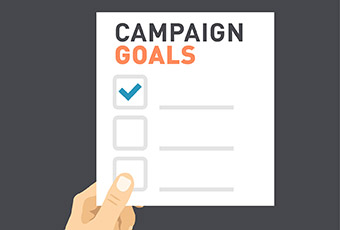
Before you start raising money from your supporters and their peers, you need to determine a few guidelines for your campaign.
First, set a financial goal. This number will vary from organization to organization, but in general, it should be realistic and achievable. You don’t want to discourage your donors by setting a goal that’s out of their reach.
Then, set up a timeline for your campaign. Most peer-to-peer campaigns last for at least a few months, but create a timeline that works for your nonprofit.
Finally, determine what event or date will signal the end of your peer-to-peer campaign. Most organizations choose a walkathon or marathon, but feel free to get creative!

Once you’ve set up the parameters for your peer-to-peer fundraising campaign, you’ll need to find donors and volunteers to fundraise on your behalf.
Look in your donor database or volunteer management software to identify supporters who regularly give to your organization, take part in your volunteer days, and attend your fundraising events. These people are your best bets for peer-to-peer fundraisers.
Then, reach out to these individuals! Depending on their relationship with your organization, you could send out a direct mail letter or simply shoot them an email.
Let them know why you’re raising money and why you want them to participate in your campaign. Give them a date to respond by to indicate if they’ll be fundraising for you.
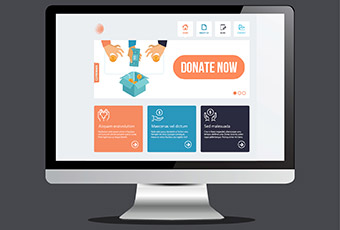
Your nonprofit will need a great peer-to-peer platform if you want to successfully accept donations and help your fundraisers reach out to their networks.
Your peer-to-peer campaign will have two different components: your main campaign page and your fundraisers’ individual pages.
Your organization will be responsible for setting up the main page, uploading photos and videos, and telling your nonprofit’s story.
This page will be your campaign’s hub, providing people with valuable info and keeping them updated on your campaign’s progress.
Your individual fundraisers will also need to set up their own fundraising pages. Most platforms allow fundraisers to customize their pages to make them unique.
Creating your peer-to-peer page is a crucial step. Without it, your donors will have a hard time contributing to your nonprofit’s campaign.

Many of your fundraisers will have never asked anyone for donations. They might feel apprehensive or nervous at the thought of asking people for money.
It’s your nonprofit’s job to prepare them for their fundraising adventure! You can accomplish this in a few ways.
First, you can assemble fundraising templates or packets that explain how your fundraisers can ask for donations. These packets can include social media and email templates that your fundraisers can customize and then post or send to their networks.
Next, you can hold meetings for the fundraisers that live nearby and remote workshops for supporters that live farther away.
Finally, let your fundraisers know that your nonprofit is available to answer any questions and help them with any roadblocks that they might run into.

As your fundraisers go out and ask for donations from their friends and family members, you’ll want to keep track of their fundraising progress as well as your nonprofit’s overall peer-to-peer goals.
Keep your financial goal in mind throughout your campaign and adjust your strategies as needed.
It might help to have each of your supporters set their own individual fundraising goal to hold them accountable throughout the campaign.
Your peer-to-peer platform can generate reports to help you track engagement over the course of your campaign.
Check the numbers every week or so to see how you’re doing!
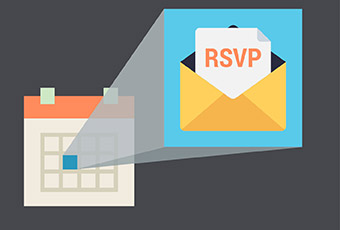
Once your fundraisers have reached their individual fundraising goals and your nonprofit has met your overall objective, it’s time to celebrate and thank your supporters for their hard work.
All of your supporters should attend the event, but they should also invite their friends and family members to participate as well.
You can use the event to thank your supporters all at once, but this should not take the place of personalized and thoughtful acknowledgements.
Within a week of the event, send out cards or emails thanking your donors for their hard work.
You should also send thank-yous to your supporters’ peers who gave to the campaign.

Peer-to-peer fundraising allows your organization to work directly with some of your biggest supporters. As you recruit donors and volunteers to be a part of your fundraising team, you are essentially letting them know that you value the relationships they have with your nonprofit.
Not only will you be able to learn more about your fundraisers, but your current supporters will enjoy forming deeper connections with your organization as they fundraise on your behalf.
It’s important that your nonprofit continues to build on and cultivate the relationships you have with your donors and volunteers. Luckily, peer-to-peer fundraising is an easy way to do just that!

Peer-to-peer fundraising allows your nonprofit to grow its donor base in a very organic and natural way.
You already know that your current supporters are passionate about your cause, and when they reach out to their friends and family members, they’re recruiting even more advocates!
Think about it this way: let’s say you have 100 fundraisers. If each of them only reaches out to two people, your donor base has just tripled in a very short amount of time.
Donor acquisition that stems from peer-to-peer fundraising efforts works because there is already trust built into the relationships between your fundraisers and their peers.
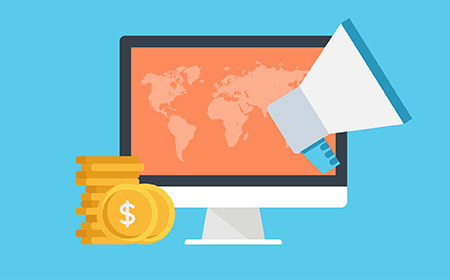
Peer-to-Peer fundraising is one of the more efficient and inexpensive ways to generate revenue for your nonprofit’s cause and mission.
Because your current supporters are the ones raising money on your behalf, your fundraising efforts are significantly broadened.
Just like P2P is an organic fundraising process, it’s also a natural way to inform others about your nonprofit and the work that you do.
As your passionate supporters ask for donations from their friends and family members, they can tell their peers about your organization and your mission.

Some nonprofit supporters might want to play a larger part in the fundraising or volunteer world but aren’t sure how to get started.
Peer-to-peer fundraising is the perfect avenue for donors and volunteers who want to be more involved but are unable to work within a nonprofit or sit on a board of directors. This fundraising method allows donors to take charge of their own nonprofit involvement.
Instead of passively giving a certain amount every month, donors can actively participate in the fundraising process and raise awareness for the nonprofit’s cause.

Most peer-to-peer fundraising campaigns are tied to events like walkathons, marathons, and other active group activities.
One of the benefits for individuals is that they get to participate in these fun events with their friends and family members.
When the event is tied to a great nonprofit cause, it becomes even more enjoyable for your donors, volunteers, and their network of peers.

For the donors and volunteers who are passionate about your cause, a peer-to-peer campaign is their chance to educate their peers.
When they ask for donations, your fundraisers can explain why your cause or mission is worth supporting and why they are so passionate about it.
While these people might already be spreading the word about your nonprofit, a peer-to-peer campaign gives them an official platform to promote your cause.
Start off on the right foot by purchasing the perfect peer-to-peer fundraising platform. The ideal platform will be user-friendly, easy to set up, feature rich, and scalable.
To successfully run a team fundraiser, you’ll need support from a mix of staff and volunteers. Your nonprofit will need to be able to handle marketing, social media, event planning, offline fundraising, and online fundraising to truly “pull off” the campaign. A diverse team with a diverse skillset is crucial.
Your campaign will need someone in charge. The leader will be responsible for coordinating your staff’s efforts as well as helping all your supporters who are taking on the role of fundraiser. Make sure that whomever you pick is social media savvy, since P2P relies so heavily on social sharing fluency.
For any P2P fundraisers that are paired with events, it’s likely that you’ll want to sell merchandise as well. You can even use it an incentive for giving. Many peer-to-peer platforms even have built-in storefronts to help you out.
Social fundraising relies on active supporters who are willing to carry the fundraising torch. Ask your most active supporters if they’d participate in a P2P campaign and be sure to get a handful to agree before diving into a full-blown fundraiser.
Peer-to-peer takes organization-wide buy-in. Even after purchasing the software, you’ll still need support from multiple members of your team. Make sure you have the buy-in before you get too far into the process.
Start off on the right foot by purchasing the perfect peer-to-peer fundraising platform. The ideal platform will be user-friendly, easy to set up, feature rich, and scalable.
To successfully run a team fundraiser, you’ll need support from a mix of staff and volunteers. Your nonprofit will need to be able to handle marketing, social media, event planning, offline fundraising, and online fundraising to truly “pull off” the campaign. A diverse team with a diverse skillset is crucial.
Your campaign will need someone in charge. The leader will be responsible for coordinating your staff’s efforts as well as helping all your supporters who are taking on the role of fundraiser. Make sure that whomever you pick is social media savvy, since P2P relies so heavily on social sharing fluency.
For any P2P fundraisers that are paired with events, it’s likely that you’ll want to sell merchandise as well. You can even use it an incentive for giving. Many peer-to-peer platforms even have built-in storefronts to help you out.
Social fundraising relies on active supporters who are willing to carry the fundraising torch. Ask your most active supporters if they’d participate in a P2P campaign and be sure to get a handful to agree before diving into a full-blown fundraiser.
Peer-to-peer takes organization-wide buy-in. Even after purchasing the software, you’ll still need support from multiple members of your team. Make sure you have the buy-in before you get too far into the process.







People don’t just throw money at fundraising campaigns; they often give because they have an emotional or personal connection to the nonprofit, the cause, or the campaign.
You can help donors and volunteers connect more closely to your campaign by telling a story of someone that has benefitted from your nonprofit’s work.
Perhaps it’s best to illustrate with an example. Let’s say that you are part of a nonprofit that helps underprivileged teens find scholarships for college. If you’re running a peer-to-peer campaign to raise money for your cause, you should tell the story of one of the students you’ve helped (with their permission, of course).
Use your campaign page and promotional materials to tell the student’s story, and encourage your fundraisers put their own personal touches to their individual campaign pages.

This tip may seem counterintuitive at first, but once we explain it will make sense. You don’t want to send your fundraisers off on their own without any guidance whatsoever.
But at the same time, your supporters probably aren’t going to be too happy if you control every single detail of their fundraising campaign.
The best way to go is to strike a healthy balance. Give your fundraiser the tools they need to be successful, but don’t impose strict guidelines or rules on them. Let them know that your nonprofit is there to support them should they need any help, but leave the bulk of the decision-making and fundraising up to them.
Over the course of the campaign, you’ll notice who among your supporters has a knack for fundraising. After the campaign, make an effort to get in touch with these people and steward them accordingly.
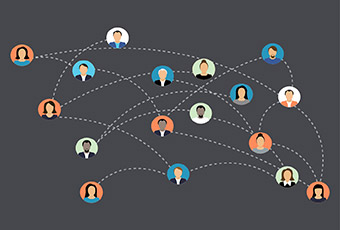
As new supporters come into your donor base, make sure that your organization is stewarding them properly. It’s easy to get caught up in the fundraising whirlwind of a peer-to-peer campaign, but don’t forget about your new donors!
Have a plan in place for when someone new gives to your campaign. Of course, you should always send out an acknowledgment email immediately after the contribution is made, but what about in the coming days and weeks?
Well, since your new donors obviously care about your organization’s cause, why not invite them to participate in your peer-to-peer event? Send out invitations via direct mail or email and watch as more and more people sign up for your event!
You can also provide new donors with other opportunities to get involved. Ask them to like your Facebook page. Direct them to information about volunteer opportunities. Or, ask if they’d like to buy merchandise from your online store.
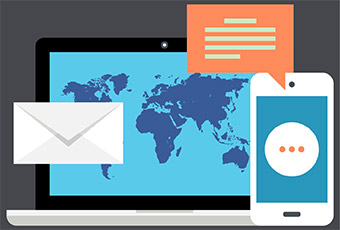
Telling your organization’s story or the narrative of someone that you’ve helped is a critical part of a peer-to-peer fundraising campaign. Equally as important are the images and videos that you pair with those stories!
Media helps to liven up a peer-to-peer campaign. Your peer-to-peer campaign page should have different images and videos that capture the spirit of your nonprofit and show donors exactly what their donations are going toward.
The images you use should be crisp and professional; no fuzzy or blurry photos! Same principle goes for any videos that you choose to upload. Additionally, make sure that anyone featured in the videos or photos has given you their permission.
You should also encourage your fundraisers to upload their own media to their personal fundraising pages. Including photos and videos is a great way to show donors where their money is going and helps to connect them to your cause.
Thanks to 16 P2P teams, this campaign raised an astonishing $70,895 from over 251 donors. The campaign was paired with a road race to raise money for the Brandywine Valley SPCA.
Donations from over 330 donors helped the Breast Cancer Resource Centers of Texas raise $36,883. The 17 peer-to-peer fundraising teams played a major role in reaching that high number.
This peer-to-peer walk/run raised an impressive $36,043 from 296 donors! 17 peer-to-peer fundraising teams stepped up to help the organization raise money and awareness.
55-64 is the average age of the most active peer-to-peer fundraising demographic.
$568 is the average amount an individual peer-to-peer fundraiser raises within a larger campaign.
38% is the percentage of peer-to-peer donations that are made on mobile devices.
8 is the average number of donors an individual peer-to-peer page will have.
Peer-to-Peer fundraising platforms are designed to help you give your P2P fundraisers the chance to create and run their own campaign pages.
The money they raise should automatically filter back into your main campaign page.
The best social fundraising software should allow you to track campaign progress, gain insights from donor data, include event registration on every page, and sell merchandise.
Learn more about Fundly’s peer-to-peer fundraising software by watching the video.
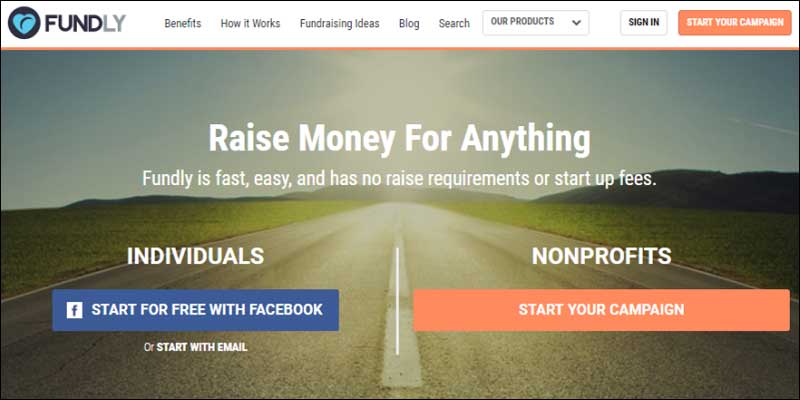 FundlyFundly doesn’t just do crowdfunding for individuals! They also have a platform for nonprofits looking to launch peer-to-peer fundraising campaigns. Fundly enables nonprofits to tell their unique stories and upload photos and videos to their peer-to-peer fundraising campaign pages. Additionally, Fundly offers a VIP package for organizations that want a little extra help with their campaign. |
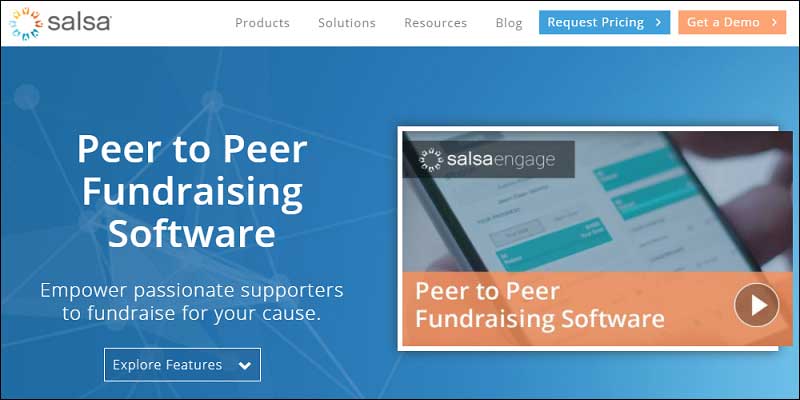 SalsaSalsa offers a comprehensive, top-of-the-line, peer-to-peer solution that meets the needs of many nonprofits. Plus, it ties seamlessly into their other suite of products, which makes the data easy to manage. |
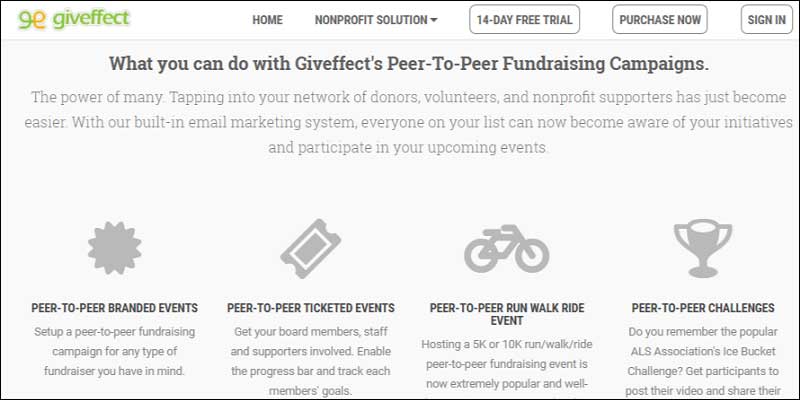 GiveeffectAs part of their extensive suite of nonprofit products, Giveffect offers a peer-to-peer fundraising platform for nonprofits of all sizes. With Giveffect, you can build out a peer-to-peer fundraiser that’s truly unique. They’ve got features designed specifically for walk-run events, workplace fundraisers, and peer-to-peer challenges. Plus, you can use Giveffect’s integrated event management tools to plan a peer-to-peer fundraising event that’s stress-free for your team and endlessly engaging for guests. Sell tickets, design a registration page, and offer discounts! |
 FundlyFundly doesn’t just do crowdfunding for individuals! They also have a platform for nonprofits looking to launch peer-to-peer fundraising campaigns. Fundly enables nonprofits to tell their unique stories and upload photos and videos to their peer-to-peer fundraising campaign pages. Additionally, Fundly offers a VIP package for organizations that want a little extra help with their campaign. |
 SalsaSalsa offers a comprehensive, top-of-the-line, peer-to-peer solution that meets the needs of many nonprofits. Plus, it ties seamlessly into their other suite of products, which makes the data easy to manage. |
 GiveeffectAs part of their extensive suite of nonprofit products, Giveffect offers a peer-to-peer fundraising platform for nonprofits of all sizes. With Giveffect, you can build out a peer-to-peer fundraiser that’s truly unique. They’ve got features designed specifically for walk-run events, workplace fundraisers, and peer-to-peer challenges. Plus, you can use Giveffect’s integrated event management tools to plan a peer-to-peer fundraising event that’s stress-free for your team and endlessly engaging for guests. Sell tickets, design a registration page, and offer discounts! |
Every fundraising campaign can use a little help every now and then! Whether you need advice about shooting and uploading photos, writing descriptions and updates, or sharing your fundraiser with your friends and family members, we’ve got your back. Click to learn more about the top crowdfunding and peer-to-peer tips that can be used for all types of fundraising efforts and campaigns!
You’ve heard the stories about fundraisers surpassing their goal, but how often does that really happen? The answer? More frequently than you might think! In fact, individuals and organizations often meet and exceed their goals when they use Fundly to set up a fundraiser and share it with their friends and family members. Check out these ten example campaigns that all exceeded their fundraising goals by sizable margins in just a matter of weeks!
Crowdfunding has been used to raise money for everything from creative projects to medical costs and more! Why is it so popular? Well, it might have something to do with the fact that a crowdfunding campaign is insanely easy to set up and share with your friends, family members, coworkers, and other peers. See for yourself! Take a look at our Ultimate Guide to Crowdfunding, and learn how you can make the most of this fundraising craze!
© Copyright - Fundly